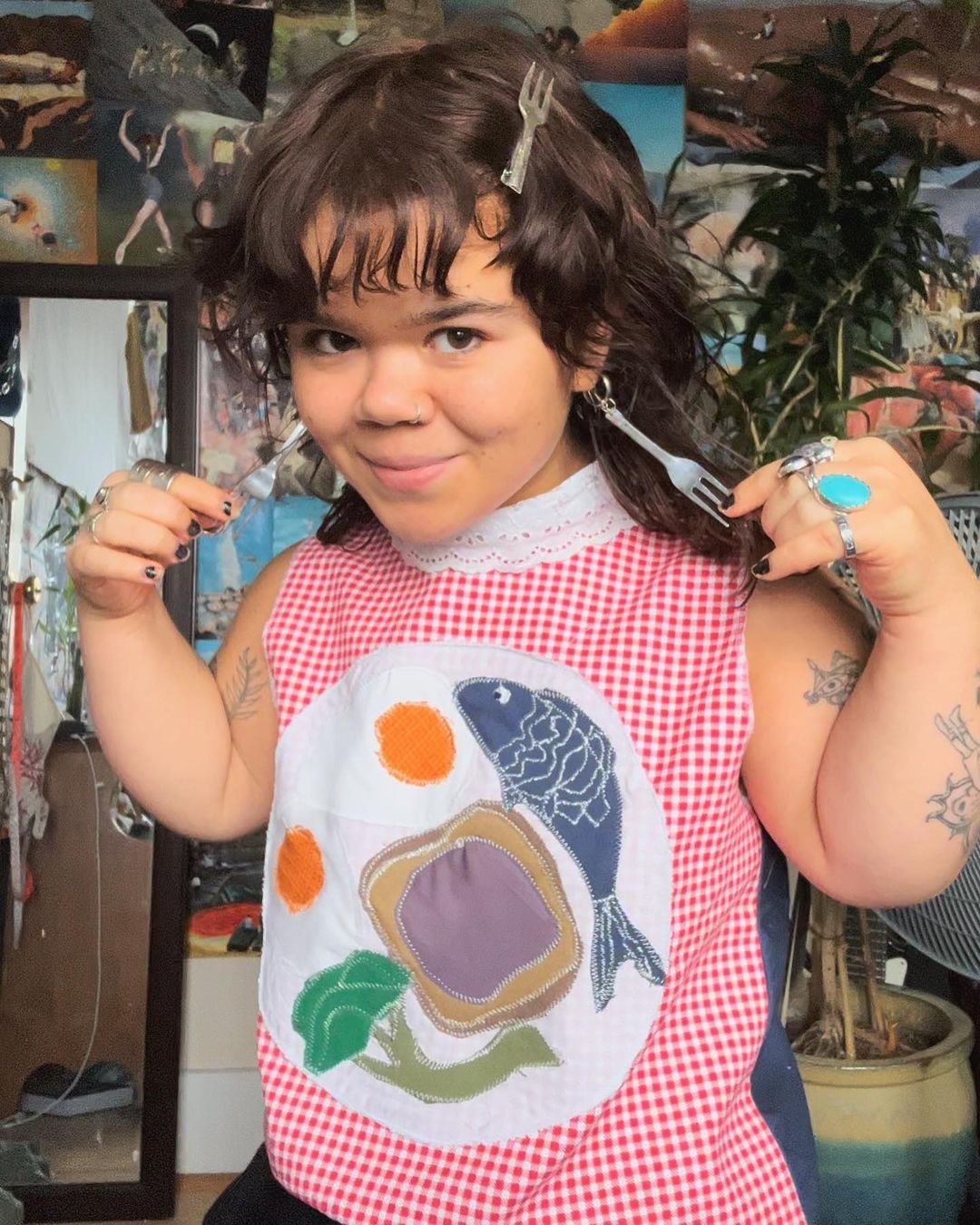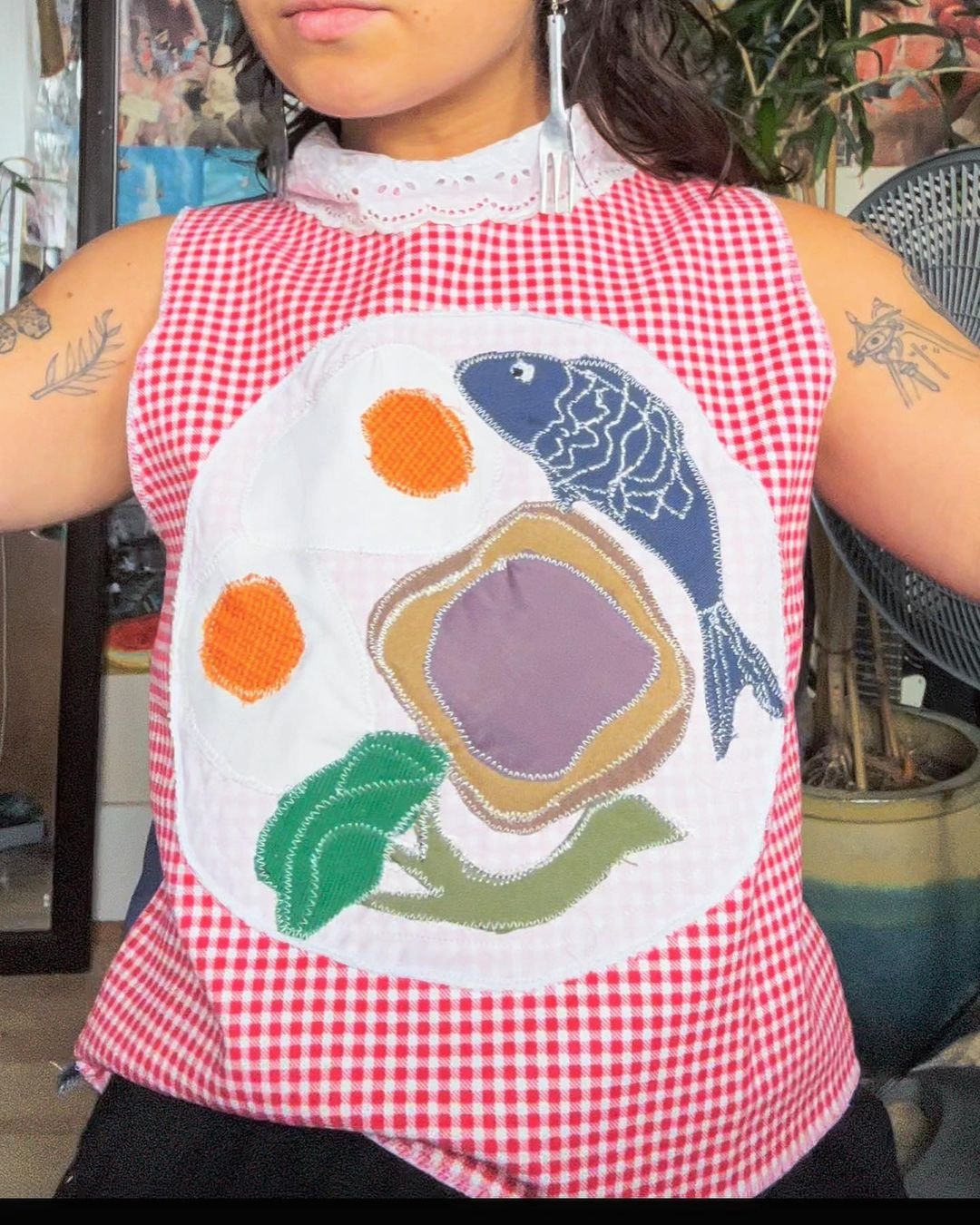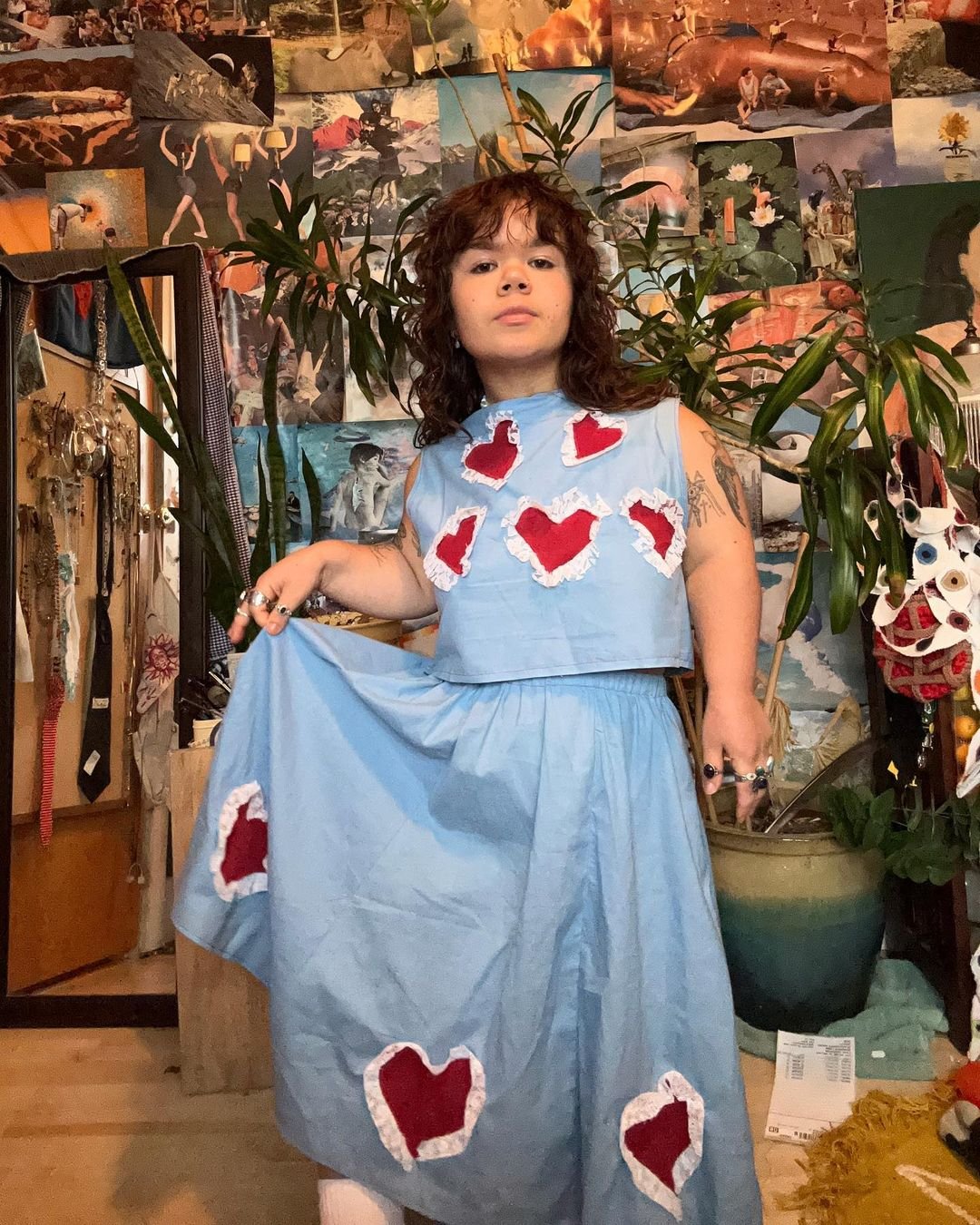Sustainable Baddie of the Week: Upcycling and Accessible Fashion with Caity B.
☀️: Libra 🌙: Aries ⬆️: Gemini
The thrift store is a place where pre-loved treasures go to find a new forever home. It's a sanctuary for sustainable baddies—in particular, the fashion-obsessed girlies. But even for the thrift-minded, rarely do we expect that our next outfit could be found on the shelves of the home decor aisle. For Caity B., Portland, Oregon-based TikToker and upcycle designer, materials for clothing creation aren’t limited to fabrics. She’s not afraid to roam through aisles full of knick-knacks to find inspiration for her next project. She might see a bowl of fake fruit at the thrift and decide to turn it into her next accessory; in fact, she’s already done this. (Using a few mini fake fruits she found and a leftover onion sac, she created a fruit tie.)
Caity’s personal style and design journey have become an outlet for her to express her inherent artistry, experiment with fashion that’s tailored to her body, and build confidence through clothing. In a digital landscape defined by fleeting trends and ever-changing content, Caity (known online as @Ca8ty) transcends boundaries through her upcycle videos and content that shines a light on accessible fashion. With a unique perspective shaped by her experiences as a person with dwarfism, she experiments with the overlap between creativity, accessibility, and sustainability. Her work inspires countless individuals to wear their creations with confidence all while expressing the need for a more inclusive fashion world.
For Caity, learning to sew unveiled infinite possibilities for self-expression, confidence, and resourcefulness. “Because I’m a little person, it’s been hard for me to find clothes. Before, my aunt would help me with sewing and altering, but in 2020 I started doing it on my own through a lot of trial and error,” Caity tells us. Tailoring is a creative endeavor for Caity, extrapolated from a baseline need for clothing that fits.
“I definitely want to be as sustainable as I can with fabrics because I know there’s so much waste created. So like, with these pants I cut in half, I thought to myself ‘How can I use the other half to make something?’”
Many of her designs are made from fabrics or clothing she finds at thrift stores like Goodwill, though, as made apparent by her fruit tie, she can work with almost anything. She’s made a raincoat out of a Twister mat, a top out of a bunch of zippers, and even accented a shirt using soda can tabs.
Before she learned to sew, Caity’s artistic nature manifested itself through collaging. Looking back at her pre-pandemic artwork, we can see the food, nature, animal, and futuristic motifs alongside a patchwork style that would soon translate into her clothing designs. Caity’s creative process involves the practice of observing what is readily available. “With some of my art, I make it and then set it aside. But with my clothes, I get to wear [my art] and get to appreciate it more. I get to bring it out to the world and show it,” she says. Rather than dreaming up an idea and searching for the perfect materials to realize it, she’s inspired by what she already has or by what reveals itself to her at the thrift. She may look through her old sketchbooks for inspiration on which artwork can become a new outfit or pick some old curtains and turn them into a dress. The result is wearable art, and Caity, a walking gallery.
Fashion is a powerful tool for self-expression, self-love, and self-empowerment, but it’s also often limited to certain individuals. It’s no secret that the fashion industry prioritizes the straight size and the able-bodied. For bodies that don’t fall into either of these categories, finding clothes that 1. fit and 2. dare to venture beyond the basic (yet ofc, valid) jeans and white tee is an unfairly difficult task.
Most mainstream brands, especially fast fashion brands, fail to understand that all human bodies are built differently, and straight sizing only caters to a select group of people. Fast fashion would rather actively marginalize people with disabilities or bodies that don't conform to the straight size standard than do the work to make long-lasting clothing that also tailors to diverse bodies.
The state of offerings for people with disabilities is a case study on the limitations of the modern fashion industry and how it falls short in serving the diverse needs of disabled bodies. When we open up conversations surrounding the challenges faced by people with non-normative bodies in expressing themselves through clothing, we expose the deep-rooted flaws in the industry's perception of clothing and style and who really has access to it. It would be wrong to say no brands are making an effort to create accessible clothing or make room for accessibility on the runway. Brands like Collina Strada and Open Style Lab are working to normalize disabled bodies in fashion spaces. However, the severe lack of representation holds strong in a largely ableist industry.
Creativity in the realm of body-inclusive fashion often emerges as a response to limited access and agency within the fashion industry. When individuals find themselves excluded from mainstream options, they are driven to explore alternative avenues for self-expression. As a person with dwarfism, the inability to find cool, well-tailored clothing became a reason for Caity to try her hand at translating her artistic capabilities into clothing design. However, it’s important to acknowledge that:
“not everyone has the ability to get a sewing machine or have the time to learn,” Caty adds. “But if the fashion industries were to become more diverse and make clothes for different body types then everybody could feel that joy that I feel when I make something that fits me that I’m proud of.”
In an ideal world, diversity and inclusivity would be the cornerstone of the fashion industry and creativity would thrive as a response to individuality, rather than limited options.
With over 100,000 TikTok followers, and growing, Caity has created a community and safe space for underrepresented bodies in the fashion world. TikTok is as much a space to inspire others as it is to find inspiration from them. It's become a platform where individuals can share their personal experiences and how they’ve creatively grown from them. Call it the algorithm or call it community, TikTok provides a sense of inclusivity. On TikTok, Caity shares her upcycle process, thrift flips, and OOTDs. “It’s opened a lot of doors for me within the fashion industry. They don't really make a lot of clothes for people with my body type, but seeing other creators and how they make things work for their body, I think ‘I can wear those things too,’” she says. “Now that I know how to sew… the boundaries and limits of clothing are so much less.” She’s been able to connect with other little people who’ve faced similar struggles when it comes to personal style. She even discovered the UK-based brand Chamiah Dewey, the UK’s first clothing brand for short-stature people under 4 '11", which recently showed at London Fashion Week.
@Ca8ty is a one-woman show! All her pieces are designed and handmade by herself, but she did let us in on the hope that one day she might be able to expand the reach of her designs and be able to share them with other little people. Caity has an upcoming collaboration with (our beloved) Fashion Brand Company, which we just know is going to be funky as hell!





